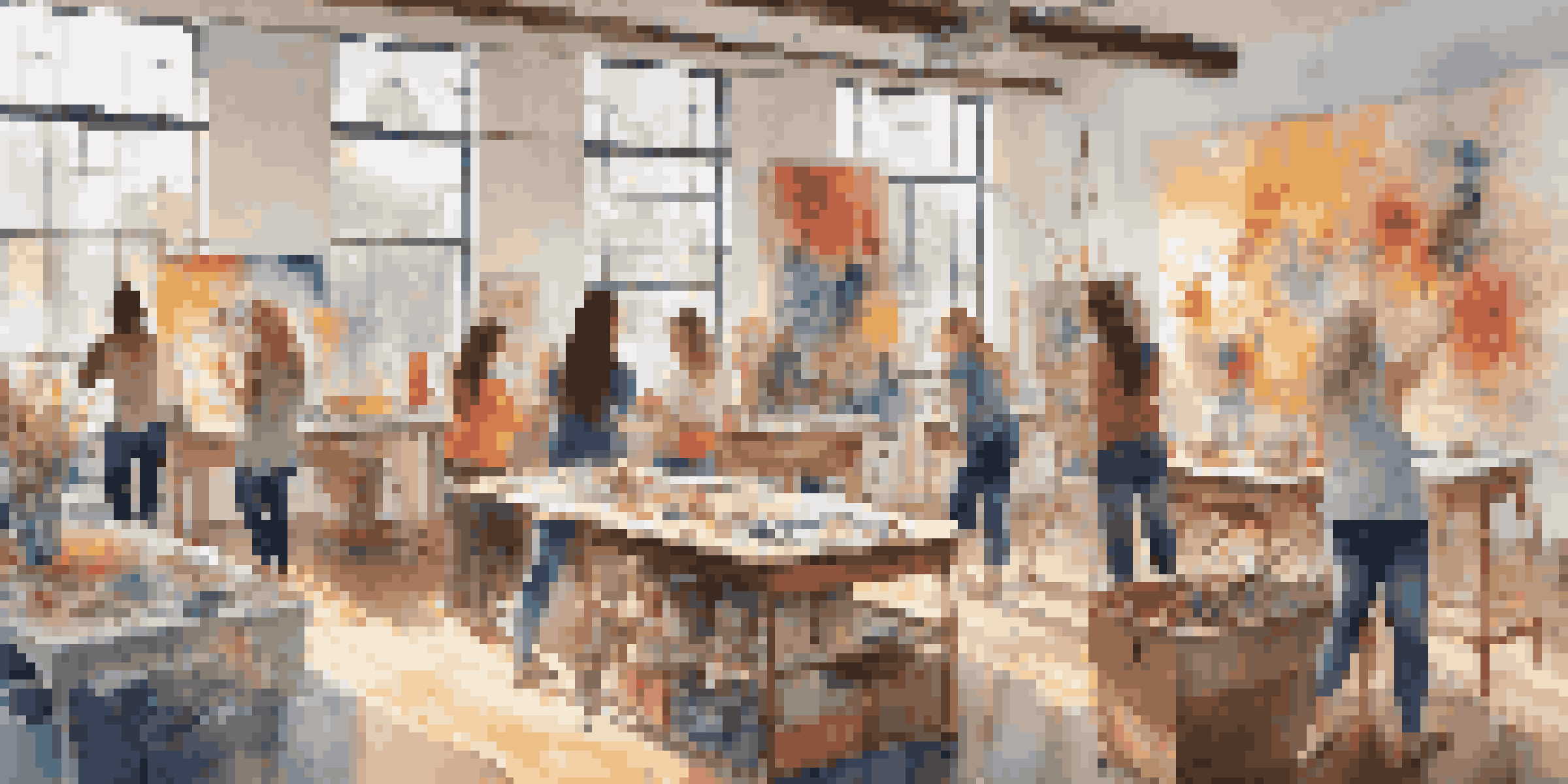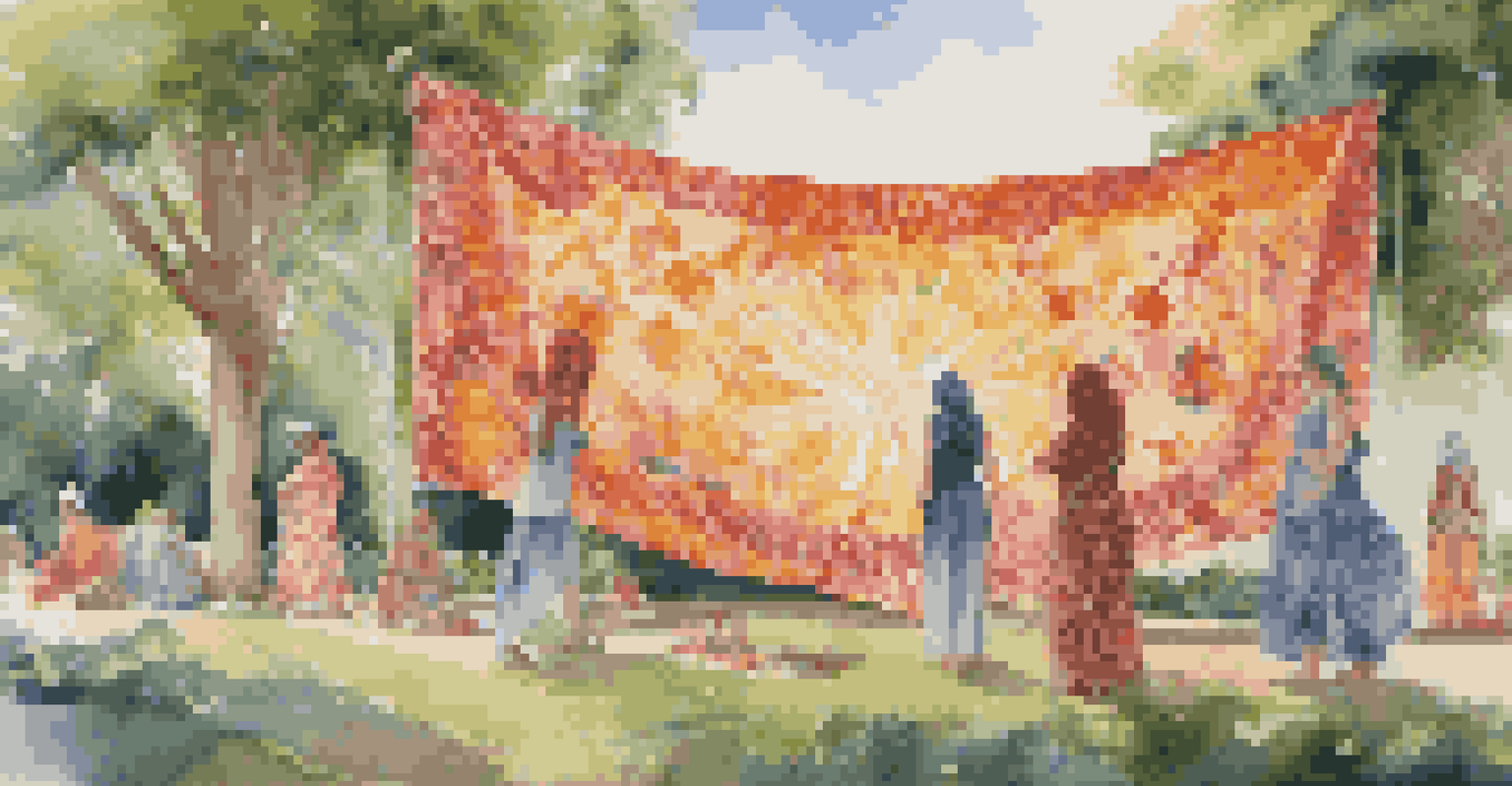The Impact of Feminism on Art: Challenging Traditional Norms

Understanding Feminism's Roots in Art
Feminism in art emerged as a response to the male-dominated narratives that have historically defined the art world. Artists began to question the roles and representations of women, creating a platform for voices that had long been silenced. By tracing the roots of feminist art, we can see how it sought not only to critique existing norms but also to redefine the very idea of art itself.
Art is a reflection of society, and as society evolves, so too must our understanding of art.
From the suffrage movement to the modern-day, feminist art has often reflected broader social changes. Artists like Judy Chicago and Barbara Kruger utilized their work to address issues of gender inequality and challenge societal expectations of women. These early pioneers laid the groundwork for future generations, encouraging a more inclusive approach to what art can represent.
As feminism gained momentum, it began to infiltrate various art movements, leading to a rich tapestry of styles and themes that prioritized women's experiences. This shift not only broadened the scope of artistic expression but also sparked conversations about identity, power, and the role of the artist. Ultimately, understanding these roots helps us appreciate the profound impact feminism has had on contemporary art.
Feminism's Challenge to Traditional Art Forms
One of the most significant impacts of feminism on art is its challenge to traditional forms and mediums. Historically, art has often been confined to specific styles and techniques, many of which were dominated by male artists. Feminist artists have pushed back against these conventions, experimenting with new forms that reflect women's diverse experiences and perspectives.

For instance, the incorporation of textiles and craft into fine art has roots in feminist movements, as these mediums were traditionally associated with women's work. Artists like Faith Ringgold have successfully merged storytelling with fabric art, creating pieces that convey powerful narratives often overlooked in mainstream art. This blending of mediums not only challenges aesthetic norms but also elevates the significance of traditionally marginalized practices.
Feminism Redefines Art Narratives
Feminism has transformed art by challenging traditional narratives and promoting diverse representations of women.
By redefining what constitutes 'serious' art, feminists have opened the door for a broader range of artistic expressions. This has led to an increased appreciation for mixed media, performance art, and installations that focus on themes of identity and gender. In doing so, feminist artists have expanded the conversation about what art can be, inviting audiences to engage with it in new and meaningful ways.
Redefining Representation in Art
Feminism has significantly influenced how women are represented in art, challenging stereotypes and promoting diverse identities. Traditional art often depicted women through a lens of objectification, reducing them to mere subjects for male artists. Feminist artists actively work to subvert these portrayals by showcasing the agency, complexity, and individuality of women.
Feminism is not just about women; it's about changing the world for everyone.
For example, artists like Cindy Sherman have used photography to explore and critique the roles women play in society. By creating a series of self-portraits in various guises, Sherman encourages viewers to question the authenticity of female representation in media and art. This approach not only empowers women but also invites critical discussions about gender roles and societal expectations.
As a result, the representation of women in art has become more nuanced and multifaceted. Contemporary feminist artists celebrate diversity, portraying women of different races, body types, and sexual orientations. This shift not only enriches the art world but also fosters a more inclusive environment that resonates with a wider audience.
Intersectionality in Feminist Art
The concept of intersectionality has become a crucial aspect of feminist art, recognizing that women's experiences are influenced by various overlapping identities. This approach allows artists to address issues such as race, class, sexuality, and disability alongside gender. By embracing intersectionality, feminist art creates a more comprehensive understanding of societal challenges.
Artists like Kara Walker and Yoko Ono illustrate how intersectionality enriches artistic narratives. Walker, through her powerful silhouettes, tackles themes of race and history, while Ono's work often emphasizes peace and activism from a feminist perspective. Both artists provide insights into how different identities shape the female experience, making their work resonate on multiple levels.
Intersectionality Enriches Art
The concept of intersectionality in feminist art highlights the overlapping identities of women, addressing race, class, and sexuality.
This inclusive approach encourages dialogue about the complexities of identity, pushing audiences to consider the varied experiences that shape women's lives. As more artists embrace intersectionality, the art world becomes a more reflective space, allowing for a broader conversation about equality and representation.
Feminism and the Art Market
Feminism has also made significant waves in the art market, challenging the economics of art and the visibility of female artists. Historically, women artists have been undervalued and underrepresented in galleries and auctions, often fetching lower prices than their male counterparts. Feminist movements have worked tirelessly to address these disparities, pushing for greater recognition and support for women's art.
Organizations like the Guerrilla Girls have brought attention to the gender gap in art institutions, using provocative campaigns to highlight the imbalance. Their efforts have sparked conversations about the importance of equitable representation, leading to initiatives aimed at promoting female artists in mainstream venues. This activism has not only increased visibility but also encouraged institutions to reevaluate their practices.
As a result, the art market is gradually shifting to become more inclusive. Female artists are increasingly claiming their space, with more exhibitions dedicated to their work and a growing interest from collectors. This change not only helps to correct historical imbalances but also enriches the art world with diverse perspectives and narratives.
Feminism's Influence on Contemporary Art Movements
Feminism's impact extends beyond just individual artists; it has influenced contemporary art movements as a whole. Many current movements, such as post-feminism and feminist art activism, draw on feminist principles to explore themes of gender and identity. This evolution showcases how feminism continues to shape artistic discourse, even in the face of changing societal contexts.
For example, the #MeToo movement has inspired a wave of artistic responses that address issues of sexual harassment and empowerment. Artists are using their platforms to raise awareness and spark conversations about these critical issues, demonstrating how feminism remains a vital force in contemporary art. This engagement not only reflects the current climate but also reinforces the importance of feminist perspectives.
Feminism Impacts Art Market
Feminist movements have worked to increase the visibility and value of female artists in the art market, correcting historical disparities.
Moreover, the integration of feminist themes into mainstream art has led to a broader acceptance of diverse narratives within various movements, including street art and digital art. As artists continue to draw inspiration from feminist ideals, the art world evolves, fostering an environment where all voices can be heard and celebrated.
The Future of Feminism in Art
Looking ahead, the future of feminism in art appears promising, with ongoing movements to challenge and redefine societal norms. As more artists embrace feminist principles, we can expect to see a continuation of innovative works that push boundaries and provoke thought. This evolution will likely lead to even greater diversity in artistic expression and representation.
Emerging artists are increasingly using social media and digital platforms to share their feminist art, reaching wider audiences than ever before. This democratization of art allows for voices from all backgrounds to contribute to the conversation, ensuring that feminism remains vibrant and relevant in the art world. The accessibility of these platforms also encourages collaboration among artists, fostering a sense of community and shared purpose.

Ultimately, the future of feminism in art is about empowerment, inclusivity, and the celebration of diverse experiences. As we continue to challenge traditional norms, the art world has the potential to become a more equitable space, reflecting the richness of human experience and the ongoing journey toward gender equality.